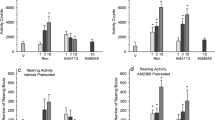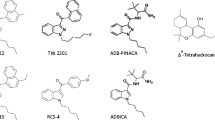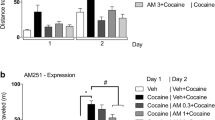Abstract
Rationale
Cannabinoid CB1 receptor agonists vary in efficacy in vitro; however, relationships between efficacy and behavioral effects are unclear.
Objective
This study examined the relationship between apparent CB1 agonist efficacy and in vivo effects.
Methods
Male C57BL/6J mice responded for food under a fixed ratio 30 schedule; rectal temperature was measured. Sensitivity of the mice to cannabinoid agonists (rank order efficacy in vitro reported to be CP 55940 > anandamide > Δ9-tetrahydrocannabinol; Δ9-THC) and a non-cannabinoid (the benzodiazepine midazolam) was determined before, during, and after discontinuation of daily Δ9-THC treatment (32 mg/kg/day, i.p.). Rimonabant was combined with cannabinoids to examine whether CB1 receptors mediated effects on response rate.
Results
Δ9-THC, CP 55940, anandamide, and midazolam decreased responding at doses smaller than those producing hypothermia. Rimonabant antagonized the rate-decreasing effects of Δ9-THC and CP 55940, but not those of anandamide. Δ9-THC treatment produced tolerance for both rate-decreasing and hypothermic effects. Δ9-THC treatment did not change sensitivity to the rate-decreasing effects of CP 55940, but produced cross-tolerance to CP 55940 for hypothermic effects. Δ9-THC treatment did not modify sensitivity to anandamide and midazolam.
Conclusions
CB1 receptors mediate the operant rate-decreasing effects of Δ9-THC and CP 55940, but not anandamide, in mice. CB1 agonist efficacy is an important determinant of in vivo effects, especially with regard to the magnitude of tolerance and cross-tolerance resulting from daily Δ9-THC treatment. This applies not only to different cannabinoids when measuring the same effect but also to the same cannabinoid when measuring different effects.





Similar content being viewed by others
References
Abood ME, Martin BR (1992) Neurobiology of marijuana abuse. Trends Pharmacol Sci 13:201–206
Adams IB, Compton DR, Martin BR (1998) Assessment of anandamide interaction with the cannabinoid brain receptor: SR 141716A antagonism studies in mice and autoradiographic analysis of receptor binding in rat brain. J Pharmacol Exp Ther 284:1209–1217
Breivogel CS, Childers SR (2000) Cannabinoid agonist signal transduction in rat brain: comparison of cannabinoid agonists in receptor binding, G-protein activation, and adenylyl cyclase inhibition. J Pharmacol Exp Ther 295:328–336
Breivogel CS, Childers SR, Deadwyler SA, Hampson RE, Vogt LJ, Sim-Selley LJ (1999) Chronic Δ9-tetrahydrocannabinol treatment produces a time-dependent loss of cannabinoid receptors and cannabinoid receptor-activated G proteins in rat brain. J Neurochem 73:2447–2459
Breivogel CS, Scates SM, Beletskaya IO, Lowery OB, Aceto MD, Martin BR (2003) The effects of Δ9-tetrahydrocannabinol physical dependence on brain cannabinoid receptors. Eur J Pharmacol 459:139–150
Childers SR (2006) Activation of G-proteins in brain by endogenous and exogenous cannabinoids. AAPS J 8:E112–E117
Coutts AA, Anavi-Goffer S, Ross RA, MacEwan DJ, Mackie K, Pertwee RG, Irving AJ (2001) Agonist-induced internalization and trafficking of cannabinoid CB1 receptors in hippocampal neurons. J Neurosci 21:2425–2433
Cravatt BF, Demarest K, Patricelli MP, Bracey MH, Giang DK, Martin BR, Lichtman AH (2001) Supersensitivity to anandamide and enhanced endogenous cannabinoid signaling in mice lacking fatty acid amide hydrolase. Proc Natl Acad Sci USA 98:9371–9376
Devane WA, Hanus L, Breuer A, Pertwee RG, Stevenson LA, Griffin G, Gibson D, Mandelbaum A, Etinger A, Mechoulam R (1992) Isolation and structure of a brain constituent that binds to the cannabinoid receptor. Science 258:1946–1949
De Vry J, Jentzsch KR (2004) Partial agonist-like profile of the cannabinoid receptor antagonist SR141716A in a food-reinforced operant paradigm. Behav Pharmacol 15:13–20
De Vry J, Jentzsch KR, Kuhl E, Eckel G (2004) Behavioral effects of cannabinoids show differential sensitivity to cannabinoid receptor blockade and tolerance development. Behav Pharmacol 15:1–12
Dewey WL (1986) Cannabinoid pharmacology. Pharmacol Rev 38:151–178
Dill JA, Howlett AC (1988) Regulation of adenylate cyclase by chronic exposure to cannabimimetic drugs. J Pharmacol Exp Ther 244:1157–1163
Di Marzo V, Berrendero F, Bisogno T, González S, Cavaliere P, Romero J, Cebeira M, Ramos JA, Fernández-Ruiz JJ (2000) Enhancement of anandamide formation in the limbic forebrain and reduction of endocannabinoid contents in the striatum of delta9-tetrahydrocannabinol-tolerant rats. J Neurochem 74:1627–1635
Falenski KW, Thorpe AJ, Schlosburg JE, Cravatt BF, Abdullah RA, Smith TH, Selley DE, Lichtman AH, Sim-Selley LJ (2010) FAAH−/− mice display differential tolerance, dependence, and cannabinoid receptor adaptation after Δ9-tetrahydrocannabinol and anandamide administration. Neuropsychopharmacology 35:1775–1787
Fan F, Compton DR, Ward S, Melvin L, Martin BR (1994) Development of cross-tolerance between Δ9-tetrahydrocannabinol, CP 55, 940 and WIN 55, 212. J Pharmacol Exp Ther 271:1383–1390
Gifford AN, Bruneus M, Gatley SJ, Lan R, Makriyannis A, Volkow ND (1999) Large receptor reserve for cannabinoid actions in the central nervous system. J Pharmacol Exp Ther 288:478–483
Giuffrida A, McMahon LR (2010) In vivo pharmacology of endocannabinoids and their metabolic inhibitors: therapeutic implications in Parkinson’s disease and abuse liability. Prostaglandins Other Lipid Mediat 91:90–103
Giuffrida A, Piomelli D (1998a) Purification and high-resolution analysis of anandamide and other fatty acylethanolamides. In: Laychock SG, Rubin RP (eds) Lipid second messengers. CRC, Boca Raton, pp 113–133
Giuffrida A, Piomelli D (1998b) Isotope dilution GC/MS determination of anandamide and other fatty acylethanolamides in rat blood plasma. FEBS Lett 422:373–376
Hardison S, Weintraub ST, Giuffrida A (2006) Quantification of endocannabinoids in rat biological samples by GC/MS: technical and theoretical considerations. Prostaglandins Other Lipid Mediat 81:106–112
Herkenham M, Lynn AB, Johnson MR, Melvin LS, de Costa BR, Rice KC (1991) Characterization and localization of cannabinoid receptors in rat brain: a quantitative in vitro autoradiographic study. J Neurosci 11:563–583
Hollister LE (1986) Health aspects of cannabis. Pharmacol Rev 38:1–20
Howlett AC (2002) The cannabinoid receptors. Prostaglandins Other Lipid Mediat 68–69:619–631
Järbe TU, Lamb RJ, Lin S, Makriyannis A (2001) (R)-methanandamide and Δ9-THC as discriminative stimuli in rats: tests with the cannabinoid antagonist SR-141716 and the endogenous ligand anandamide. Psychopharmacology 156:369–380
Järbe TU, Lamb RJ, Liu Q, Makriyannis A (2003) (R)-Methanandamide and Δ9-tetrahydrocannabinol-induced operant rate decreases in rats are not readily antagonized by SR-141716A. Eur J Pharmacol 466:121–127
Kenakin T (1997) Pharmacologic analysis of drug–receptor interaction. Lippincott-Raven, Philadelphia
Kenakin T (2002) Efficacy at G-protein-coupled receptors. Nat Rev Drug Discov 1:103–110
Martin BR, Compton DR, Thomas BF, Prescott WR, Little PJ, Razdan RK, Johnson MR, Melvin LS, Mechoulam R, Ward SJ (1991) Behavioral, biochemical, and molecular modeling evaluations of cannabinoid analogs. Pharmacol Biochem Behav 40:471–478
McMahon LR (2009) Apparent affinity estimates of rimonabant in combination with anandamide and chemical analogs of anandamide in rhesus monkeys discriminating Δ9-tetrahydrocannabinol. Psychopharmacology 203:219–228
Mechoulam R, Gaoni Y (1965) A total synthesis of DL-delta-1-tetrahydrocannabinol, the active constituent of hashish. J Am Chem Soc 87:3273–3275
National Research Council (2003) Guidelines for the care and use of mammals in neuroscience and behavioral research. National Academies, Washington
Oviedo A, Glowa J, Herkenham M (1993) Chronic cannabinoid administration alters cannabinoid receptor binding in rat brain: a quantitative autoradiographic study. Brain Res 616:293–302
Pertwee RG (1988) The central neuropharmacology of psychotropic cannabinoids. Pharmacol Ther 36:189–261
Pertwee RG, Stevenson LA, Griffin G (1993) Cross-tolerance between Δ9-tetrahydrocannabinol and the cannabimimetic agents, CP 55, 940, WIN 55, 212-2 and anandamide. Br J Pharmacol 110:1483–1490
Rodríguez de Fonseca F, Gorriti MA, Fernández-Ruiz JJ, Palomo T, Ramos JA (1994) Downregulation of rat brain cannabinoid binding sites after chronic Δ9-tetrahydrocannabinol treatment. Pharmacol Biochem Behav 47:33–40
Selley DE, Cassidy MP, Martin BR, Sim-Selley LJ (2004) Long-term administration of Δ9-tetrahydrocannabinol desensitizes CB1-, adenosine A1-, and GABAB-mediated inhibition of adenylyl cyclase in mouse cerebellum. Mol Pharmacol 66:1275–1284
Sim LJ, Hampson RE, Deadwyler SA, Childers SR (1996) Effects of chronic treatment with Δ9-tetrahydrocannabinol on cannabinoid-stimulated [35S]GTPgammaS autoradiography in rat brain. J Neurosci 16:8057–8066
Smith TH, Sim-Selley LJ, Selley DE (2010) Cannabinoid CB1 receptor-interacting proteins: novel targets for central nervous system drug discovery? Br J Pharmacol 160:454–466
Solinas M, Tanda G, Justinova Z, Wertheim CE, Yasar S, Piomelli D, Vadivel SK, Makriyannis A, Goldberg SR (2007) The endogenous cannabinoid anandamide produces Δ9-tetrahydrocannabinol-like discriminative and neurochemical effects that are enhanced by inhibition of fatty acid amide hydrolase but not by inhibition of anandamide transport. J Pharmacol Exp Ther 321:370–380
Tallarida RJ (2000) Drug synergism and dose–effect data analysis. Chapman and Hall, Boca Raton
Wiley J, Balster R, Martin B (1995) Discriminative stimulus effects of anandamide in rats. Eur J Pharmacol 276:49–54
Wiley JL, Golden KM, Ryan WJ, Balster RL, Razdan RK, Martin BR (1997) Evaluation of cannabimimetic discriminative stimulus effects of anandamide and methylated fluoroanandamide in rhesus monkeys. Pharmacol Biochem Behav 58:1139–1143
Wiley JL, Razdan RK, Martin BR (2006) Evaluation of the role of the arachidonic acid cascade in anandamide’s in vivo effects in mice. Life Sci 80:24–35
Willoughby KA, Moore SF, Martin BR, Ellis EF (1997) The biodisposition and metabolism of anandamide in mice. J Pharmacol Exp Ther 282:243–247
Acknowledgments
Supported by U.S. Public Health Service Grants DA19222 and DA26781.
Author information
Authors and Affiliations
Corresponding author
Rights and permissions
About this article
Cite this article
Singh, H., Schulze, D.R. & McMahon, L.R. Tolerance and cross-tolerance to cannabinoids in mice: schedule-controlled responding and hypothermia. Psychopharmacology 215, 665–675 (2011). https://doi.org/10.1007/s00213-010-2162-7
Received:
Accepted:
Published:
Issue Date:
DOI: https://doi.org/10.1007/s00213-010-2162-7




